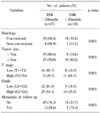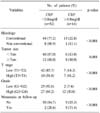Abstract
Purpose
This study was performed to investigate the significance of preoperative erythrocyte sedimentation rate (ESR) and C-reactive protein (CRP) and postoperative ESR and CRP nadir as predictive factors for prognosis in patients with non-metastatic renal cell carcinoma (RCC).
Materials and Methods
In 66 patients with non-metastatic RCC for whom ESR and CRP could be measured before radical nephrectomy and during follow-up, the preoperative ESR, preoperative CRP, postoperative ESR nadir and postoperative CRP nadir were compared with the clinicopathological variables.
Results
Patients with elevated preoperative ESR or CRP levels were more likely to have tumors with adverse features, including larger tumor size, higher T stage, higher nuclear grade and more frequent metastasis at follow-up, as compared to those patients with lower preoperative ESR or CRP levels, respectively. Patients with an elevated postoperative CRP nadir developed metastasis more frequently at follow-up as compared to those patients with a lower level of postoperative CRP nadir. The univariate analyses identified tumor size, T stage, preoperative ESR, preoperative CRP and postoperative CRP nadir as significant prognostic factors for recurrence-free survival.
Figures and Tables
Table 2
Relationship between preoperative erythrocyte sedimentation rate (ESR) level and clinicopathological variables

References
1. Gudbjartsson T, Thoroddsen A, Petursdottir V, Hardarson S, Magnusson J, Einarsson GV. Effect of incidental detection for survival of patients with renal cell carcinoma: results of population-based study of 701 patients. Urology. 2005. 66:1186–1191.
2. Leibovich BC, Blute ML, Cheville JC, Lohse CM, Frank I, Kwon ED, et al. Prediction of progression after radical nephrectomy for patients with clear cell renal cell carcinoma: a stratification tool for prospective clinical trials. Cancer. 2003. 97:1663–1671.
3. Levy DA, Slaton JW, Swanson DA, Dinney CP. Stage specific guidelines for surveillance after radical nephrectomy for local renal cell carcinoma. J Urol. 1998. 159:1163–1167.
4. Ljungberg B, Grankvist K, Rasmuson T. Serum acute phase reactants and prognosis in renal cell carcinoma. Cancer. 1995. 76:1435–1439.
5. Ljungberg B, Landberg G, Alamdari FI. Factors of importance for prediction of survival in patients with metastatic renal cell carcinoma, treated with or without nephrectomy. Scand J Urol Nephrol. 2000. 34:246–251.
6. Masuda H, Kurita Y, Suzuki K, Fujita K, Aso Y. Predictive value of serum immunosuppressive acidic protein for staging renal cell carcinoma: comparison with other tumour markers. Br J Urol. 1997. 80:25–29.
7. Sung KT, Park NC, Yoon JB. Clinicopathological study of renal cell carcinoma: prognostic factors. Korean J Urol. 1990. 31:29–36.
8. Hwang C, Chang SG. Clinical significance of serum C-reactive protein in patients with renal cell carcinoma. Korean J Urol. 1999. 40:864–868.
9. Brigden ML. Clinical utility of the erythrocyte sedimentation rate. Am Fam Physician. 1999. 60:1443–1450.
10. Johansson JE, Sigurdsson T, Holmberg L, Bergstrom R. Erythrocyte sedimentation rate as a tumor marker in human prostatic cancer. An analysis of prognostic factors in 300 population-based consecutive cases. Cancer. 1992. 70:1556–1563.
11. Guillem P, Triboulet JP. Elevated serum levels of C-reactive protein are indicative of a poor prognosis in patients with esophageal cancer. Dis Esophagus. 2005. 18:146–150.
12. Henry-Amar M, Friedman S, Hayat M, Somers R, Meerwaldt JH, Carde P, et al. The EORTC Lymphoma Cooperative Group. Erythrocyte sedimentation rate predicts early relapse and survival in early-stage Hodgkin disease. Ann Intern Med. 1991. 114:361–365.
13. Dönmez T, Kale M, Özyürek Y, Atalay H. Erythrocyte sedimentation rates in patients with renal cell carcinoma. Eur Urol. 1992. 21:Suppl 1. 51–52.
14. Miyata Y, Koga S, Nishikido M, Noguchi M, Kanda S, Hayashi T, et al. Predictive values of acute phase reactants, basic fetoprotein, and immunosuppressive acidic protein for staging and survival in renal cell carcinoma. Urology. 2001. 58:161–164.
15. Lehmann J, Retz M, Nürnberg N, Schnöckel U, Raffenberg U, Krams M, et al. The superior prognostic value of humoral factors compared with molecular proliferation markers in renal cell carcinoma. Cancer. 2004. 101:1552–1562.
16. Inoue T, Hashimura T, Iwamura H, Takahashi T, Segawa T, Kakehi Y, et al. Multivariate analysis of prognostic determinants after surgery for renal cell carcinoma at Himeji National Hospital. Hinyokika Kiyo. 2000. 46:229–234.
17. Masuda H, Kurita Y, Fukuta K, Mugiya S, Suzuki K, Fujita K. Significant prognostic factors for 5-year survival after curative resection of renal cell carcinoma. Int J Urol. 1998. 5:418–422.
18. Ljungberg B, Grankvist K, Rasmuson T. Serum interleukin-6 in relation to acute-phase reactants and survival in patients with renal cell carcinoma. Eur J Cancer. 1997. 33:1794–1798.
19. Atzpodien J, Royston P, Wandert T, Reitz M. DGCIN-German Cooperative Renal Carcinoma Chemo-Immunotherapy Trials Group. Metastatic renal cell carcinoma comprehensive prognostic system. Br J Cancer. 2003. 88:348–353.
20. Casamassima A, Picciariello M, Quaranta M, Berardino R, Ranieri C, Paradiso A, et al. C-reactive protein: a biomarker of survival in patients with metastatic renal cell carcinoma treated with subcutaneous interleukin-2 based immunotherapy. J Urol. 2005. 173:52–55.
21. Fossa SD, Kramar A, Droz JP. Prognostic factors and survival in patients with metastatic renal cell carcinoma treated with chemotherapy or interferon-α. Eur J Cancer. 1994. 30A:1310–1314.
22. Sengupta S, Lohse CM, Cheville JC, Leibovich BC, Thompson RH, Webster WS, et al. The preoperative erythrocyte sedimentation rate is an independent prognostic factor in renal cell carcinoma. Cancer. 2006. 106:304–312.
23. Guinan P, Sobin LH, Algaba F, Badellino F, Kameyama S, MacLennan G, et al. TNM staging of renal cell carcinoma: Workgroup No. 3. Union Internationale Contre le Cancer (UICC) and the American Joint Committee on Cancer (AJCC). Cancer. 1997. 80:992–993.
24. Fuhrman SA, Lasky LC, Limas C. Prognostic significance of morphologic parameters in renal cell carcinoma. Am J Surg Pathol. 1982. 6:655–663.
25. Clyne B, Olshaker JS. The C-reactive protein. J Emerg Med. 1999. 17:1019–1025.




 PDF
PDF ePub
ePub Citation
Citation Print
Print





 XML Download
XML Download